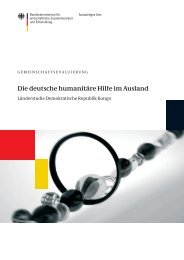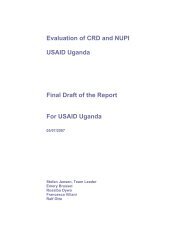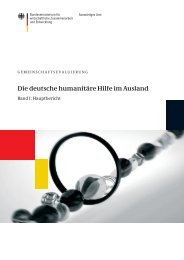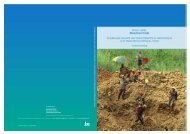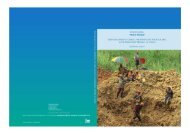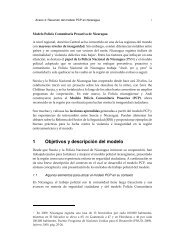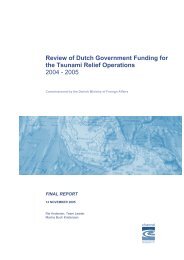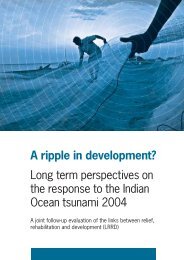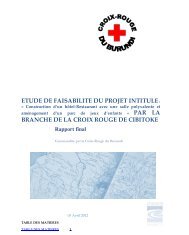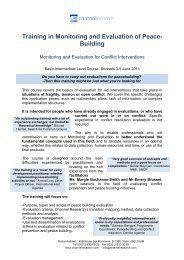German Humanitarian Aid Abroad - Channel Research
German Humanitarian Aid Abroad - Channel Research
German Humanitarian Aid Abroad - Channel Research
You also want an ePaper? Increase the reach of your titles
YUMPU automatically turns print PDFs into web optimized ePapers that Google loves.
availability of resource persons, the overall schedule of the field mission and of the specific<br />
project field visits, some flexibility in the combinations of methods was necessary. Details on<br />
the programme of the evaluation, the itinerary of the project field visits and the contacted<br />
resource persons that allowed for this data collection can be found in Annexes 2, 4 and 5).<br />
Methods<br />
Essentially, the following methods, which allow for a good triangulation of information and<br />
data sources, 9 were applied for primary data collection at different levels:<br />
• Analysis of AA and BMZ databases of HA interventions (as reported according to<br />
budget lines);<br />
• Analysis of project case studies: project cases were selected (see Chapter 1.2.2) for<br />
a more detailed analysis 10 ;<br />
• Semi-structured interviews of relevant resource persons in <strong>German</strong>y, Kampala and at<br />
project/field level: based on a stakeholder identification (see Annex 10 of the Uganda<br />
Inception Report), relevant discussion partners were identified and respective<br />
contacts prioritised before, during and after the field mission, i.e. representatives of<br />
the AA, the BMZ, the <strong>German</strong> Embassy, the implementing partners of the AA and<br />
BMZ (IOs, NOs as selected for project case studies), the local partners of the<br />
AA/BMZ implementing partners, government representatives (political and technical<br />
level), other IOs (OCHA, DG ECHO and ICRC<br />
11 ), other projects (UNHCR-BMZ-<br />
Partnership Operation, GTZ Water Sector Programme 12 ) and an advisor in the Office<br />
of the Prime Minister (OPM) as well as representatives of village/community<br />
development and user committees and beneficiaries of <strong>German</strong> funded HA projects;<br />
• Briefing Workshop: This workshop served the double purposes of informing about the<br />
evaluation and providing space for questions as well as collecting stakeholders views<br />
and perspectives related to major evaluation questions and topics through a<br />
standardised questionnaire and a semi-structured group discussion; the list of<br />
participants at the briefing workshop is presented in the Debriefing Note of the<br />
evaluation (see Annex 6);<br />
• Semi structured group discussions with representatives of village committees, user<br />
committees, beneficiaries and non-beneficiaries;<br />
• Direct observation of project activities and results, for example boreholes and pumps,<br />
school latrines, demonstration fields, beneficiaries’ fields and gardens, tree nursery,<br />
theatre rehearsal; these visits at field level were also the opportunity to deepen some<br />
specific evaluation questions and issues (as per evaluation matrix);<br />
8 Lessons learnt with this approach are presented in a separate paper.<br />
9 See Glossary for the understanding of this technical term.<br />
10 It has, however, to be stressed that these are not project evaluations, but project cases are taken as<br />
examples of various types of interventions financed in the context of <strong>German</strong> HA.<br />
11 These were important resource persons to understand the complexity of the crises, the international<br />
response to the humanitarian crises as well as the coordination, planning and steering mechanisms.<br />
12 They were contacted for background information and LRRD considerations.<br />
3



